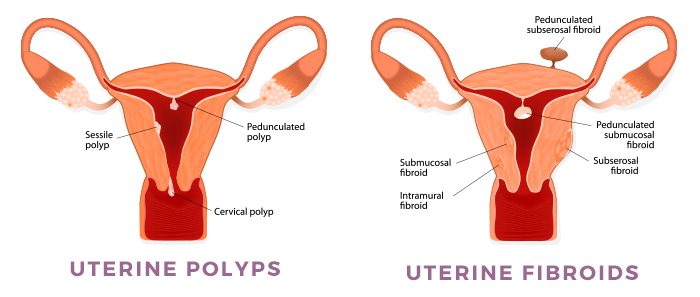Both are uterine growths. The main difference? Fibroids and polyps contain very different types of tissue. Fibroids are made of dense, connective fibrous tissue. (The word fibroid comes from fibrous.) Polyps are made of endometrial tissue, the tissue found in the uterine lining.
Why is recognizing the difference important? Both types of growth can cause heavy periods, irregular periods, or fertility issues, but fibroids are not, by definition, cancerous. In contrast, uterine polyps do have the potential to become cancer. Therefore, your health practitioner should be monitoring for changes in size and to any of your symptoms. If you live in Southern California, you can find exceptional care in Los Angeles at the Fibroid Treatment Collective. We welcome patients across the region to us visit our clinic for UFE and other medical solutions.
What Are Uterine Fibroids?
The first thing to know about fibroids is that they are NOT cancer. Patients often feel stressed when they are first diagnosed. Yes, fibroids are a kind of tumor, but they are benign. While they can cause uncomfortable and occasionally debilitating symptoms, they are also very treatable without surgery.
A fibroid is a type of benign growth that can occur in or even outside the uterus. Roughly 75% of all women will develop fibroids at some point in their lifetime. That means millions of women across Southern California will likely develop fibroids. In Los Angeles alone, well over 1 million women in the current population either have had or will have fibroids.
Most will be asymptomatic. Many fibroids will resolve on their own. But they can lead to a wide range of uncomfortable and inconvenient symptoms. So it’s essential to take control of your treatment options and not just quietly suffer from the issues fibroids can cause:
- Pain and excessive bleeding
- Fertility issues
- Distended abdomen and weight gain
- Urinary issues or incontinence
- Painful sex and lowered sex drive
- Feelings of isolation and depression
- Anemia and anemia related fatigue
- Anxiety-related to uncontrolled symptoms such as unexpected, heavy bleeding
What Are Uterine Polyps?
Uterine polyps are very different from fibroids. The lining of the uterus begins to produce polyps instead of being normally shed during menstruation. Polyps are essentially an overgrowth of cells that would usually be flushed out as part of the female body’s natural build-up and shedding of the endometrial lining. While fibroids and polyps occur in the same area (uterine tissue), it’s important to recognize they are very different types of growths.
Symptoms of Uterine Polyps
Some women never experience symptoms from polyps. Polyps may also occur and then go away on their own. It’s important to watch out for key signs that may indicate lingering or increasingly aggressive symptoms caused by persistent polyps. See a practitioner who knows the difference between polyps and fibroids. Symptoms caused by polyps may be:
- Irregular menstrual bleeding
- Bleeding between menstrual periods
- Excessively heavy menstrual periods
- Vaginal bleeding after menopause
- Infertility
Why Is the Difference Between Polyps and Fibroids Important?
For starters, it is always important to know exactly what is happening in your body. The more you know, the better you can keep your overall health, shaping your diet and lifestyle to match. But, it is especially important to know about polyps vs fibroids because polyps can lead to serious health issues, such as:
- Cancer
- Irregular menstrual periods and instability of “normal” cycles
- Vaginal bleeding
- Infertility
While fibroids can also lead to some of these, they are easily treated with non-surgical embolization. The Fibroid Treatment Collective in Los Angeles is the best location in Southern California for this pioneering treatment. Polyps also can be treated, but severe ones often require surgical removal instead of non-invasive techniques.
Uterine Polyps vs Fibroids: A Closer Look
Uterine growths may form in similar locations, but there is still a difference between polyps and fibroids. Physically, polyps occur on a different tissue than fibroids. Specifically, polyps form from endometrial tissue along the uterus lining. Typically, they remain quite small, rarely growing to any larger than a couple centimeters in diameter. But, they can also regress and shrink all on their own. It is important to know that while polyps do not always lead to cancer, they can still pose a risk. That is why we recommend removing and testing one or more to establish the situation.
Fibroids, on the other hand, can vary significantly in size, with some growing to extremely large proportions and stretching the uterus. Still, they also have the potential to shrink, but they do not regress. While we have non-surgical methods for removing fibroids, such techniques have not yet developed for removing polyps. The best non-surgical option for polyps is to try controlling them with hormone-balancing drugs, but this might not eliminate the problem entirely. If symptoms persist, surgery may be required to remove polyps.
Schedule Your Consultation Today
Once you have been diagnosed with either fibroids or polyps, begin building a treatment plan that will keep you healthy and safe. At the Los Angeles Fibroid Treatment Collective, we’ve helped countless women find relief from fibroids through non-surgical Uterine Fibroid Embolization. This specialized approach allows you to avoid surgery. But it is not appropriate as a uterine polyp treatment. Patients across Southern California can readily travel to LA for this minimally invasive treatment without the need for. a lengthy recovery stay.
If you think you might have uterine fibroids or polyps, contact us today to schedule a consultation. We’ll begin working with you to determine the cause of your symptoms and the treatment most suited to relieve them. Taking action now is the best way to end the uncertainty and anxiety that keep women caught in a cycle of fear and bad health.

